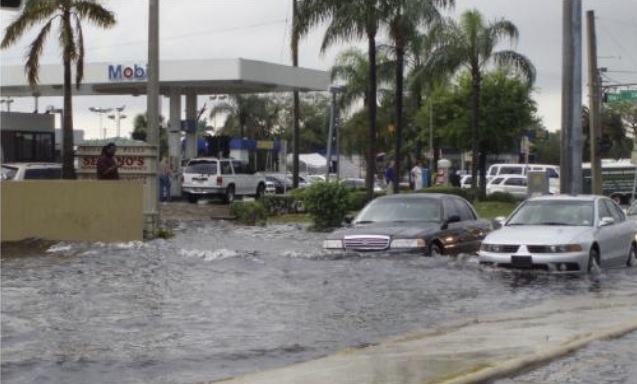Lake Management and Hurricane Season, by AllState Resource Management
Lake Management and Hurricane Season
by AllState Resource Management
Many South Florida homeowners are not aware of the critical role their community lakes play in managing stormwater and mitigating local area flooding. With the start of this year’s hurricane season around the corner, now is the time to make sure that our lakes and waterways are ready to deal with whatever nature throws at us. The problem of flooding is a real issue here because our homes are built on relatively flat, low-lying ground. The thin layer of soil under our feet can become saturated quickly, and sits on a cap of coral rock that only allows for a slow flow of water down to the aquifers below. This, combined with the possibility of large amounts of precipitation in short periods of time creates conditions for major flooding in our urban areas.
 When developers create residential communities and commercial areas, they need to take into account how much water needs to be stored or moved in order to prevent the project from flooding during major rain events. Through careful planning and design, they route stormwater away from our homes and into a system of lakes and canals. The size and number of lakes in our communities are a result of those calculations. Lakes are dug to create a storage area for water runoff from storms. The fill dug from the lakes is then used to raise the elevation of the homes around them.
When developers create residential communities and commercial areas, they need to take into account how much water needs to be stored or moved in order to prevent the project from flooding during major rain events. Through careful planning and design, they route stormwater away from our homes and into a system of lakes and canals. The size and number of lakes in our communities are a result of those calculations. Lakes are dug to create a storage area for water runoff from storms. The fill dug from the lakes is then used to raise the elevation of the homes around them.Using a system of drains and pipes the water is directed from the developed areas down into the lakes. Some community lakes use weirs or culverts to connect them to the municipal canal system. This allows them to move excess water off the property once they reach a certain level. The system works well but requires regular maintenance in order to ensure that it works properly when needed. Scheduled inspections of storm drains and weirs is important to keep the water moving off our streets and properties efficiently.
These structures accumulate silt and debris, and will occasionally need to be cleaned out. The lakes themselves also need to be regularly inspected and maintained
Even though they are primarily man-made storm water basins, they do evolve and become living ecosystems like naturally occurring waterbodies. Aquatic vegetation begins to grow in all lakes eventually, and much like our lawns, require regular attention in order to avoid become overgrown. Exotic species such as hydrilla, hygrophila, and rotala grow quickly and can spread throughout acres of lake in a matter of months or less. Such infestations are not only unsightly, but all those weeds are filling up the lake and taking up space meant to hold stormwater runoff.
Floating weeds such as water lettuce and water hyacinth can rapidly cover a lake surface, clogging and even damaging weirs and other outflows. Excessive growth of vegetation near culverts and drain pipes can slow the flow of stormwater both into and out of the lake, causing backups of the system. The longer these plants are left to grow unmanaged, the harder the problem is to get under control and the longer it will take. Large scale infestations need to be treated in stages with regulated wait times between treatments. This is done in order to not deplete the dissolved oxygen in the whole lake. The other problem with established infestations is that the plants have had time to mature and grow extensive roots systems. These root systems allow the plants to re-grow quickly after initial treatments and quite frequently require multiple follow up treatments to bring under control. Even once treated, the herbicides take time to work and the plants take time to decompose and settle to the bottom. Unfortunately, tropical storm events do not wait until conditions are best suited to deal with the results.
The best way to make sure your community is protected is to be proactive and maintain your system regularly. Regular scheduled maintenance ensures that aquatic vegetation is kept at levels that don’t compromise your stormwater system and can potentially avoid costly repairs to its components.
Hurricane season corresponds with the time of year when these plants grow and spread the fastest due to the long, sunny days. We have learned that being prepared for hurricane season means taking precautions before the storm arrives. That wisdom should also definitely apply to
our first line of defense against flood damage in our communities.
Thank You to Colleen Sullivan for this Article.
Author: Stephen Montgomery / Senior Biologist
Allstate Resource Management Members of SFPMA
– Over 25 years of experience in maintaining the health of lakes, ponds, wetlands, and stormwater systems. We have continued since our inception to be the leader in resource management. Our services include lake management, wetland management, stormwater inspections and maintenance, erosion control, fish stocking, native plantings, debris removal, water quality, aquatic pest control, and upland management.
Discover more from SFPMA
Subscribe to get the latest posts sent to your email.



